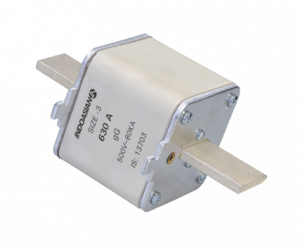
Everything you need to know about HRC fuse
A fuse is an extremely important electrical safety device that offers protection against fire hazards and accidents. The functioning of a HRC fuse follows a simple mechanism—whenever there is an overproduction of current in a circuit, the metal wire inside the fuse melts, stopping the current flow. This protects us from accidents.
Though it broadly performs the same function, the fuse can be of different types, with the classifications generally depending on the voltage ratings and the breaking function.
HRC fuse and its uniqueness:
Among the many categories, one of the prominent ones is HRC (High Rupturing Capacity) fuses which carry a short circuit current safely within a given period. The uniqueness of an HRC fuse is that if the fault in an electrical system is fixed within that given period, it does not blow off even if there is an overproduction of current. However, after that set period, the fuse wire melts, interrupting the power supply.
Use of HRC fuse:
HRC fuses are widely used in industrial installations and public power grids, such as transformer stations. However, low-voltage HRC fuses are also in areas with main distribution boards, particularly in low-voltage networks with a high prospective short-circuit current.
Working principle of HRC fuse:
An HRC fuse is generally made up of glass or a high heat-resistant body like ceramic. While the body of the fuse includes metal-end caps welded through an element that carries the current, its internal space is filled with material like quartz, dust, marble, or chalk. This prevents the fuse from overheating even when there is an overflow of current in the system. Therefore, the fuse functions for a specific period even when there is a surge but blows off after that period.
Types of HRC fuse
The HRC fuse can generally be of three different types—the NH type fuse, the Din type fuse, and the Blade type fuse.
Typically used for the starter of a motor, the NH-type fuse offers protection in case of short-circuits and overload for low and medium-voltage systems. The Din-type fuse can be used for various rated currents and in different electrical systems. They are popularly used in gas-insulated switchgear and transformers.
The Blade-type fuse has a plastic body and two metal caps to be arranged with the socket. It is generally used in cars and motors to offer protection in a short
circuit.
Advantages of HRC fuse
HRC fuses are extremely popular because they are cost-effective, easy to design, and have low-maintenance requirements. Due to its high breaking capacity, it can withstand surges in current supply, giving more time for defective systems to be repaired.
Though they can sometimes lead to overheating of the system, on the whole, their advantages outnumber their disadvantages, and they can offer great safety backup in electrical systems. Visit IndoAsian.
